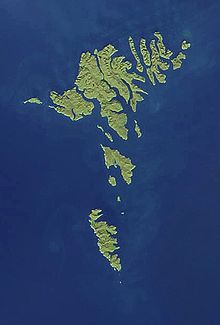- Geography of the Faroe Islands
-
The Faroe Islands are an island group consisting of eighteen islands off the coast of Northern Europe, between the Norwegian Sea and the North Atlantic, about half-way between Iceland and Norway. Its coordinates are 62°N 7°W / 62°N 7°W. It is 1,393 square kilometres in area, and includes no major lakes or rivers. There are 1,117 kilometres of coastline, and no land boundaries with any other country.
The Faroe Islands generally have cool summers and mild winters, with a usually overcast sky and frequent fog and strong winds. Although at a high latitude, due to the Gulf Stream, their climate is ameliorated. The islands are rugged and rocky with some low peaks; the coasts are mostly bordered by cliffs. The Faroe Islands are notable for having the highest sea cliffs in Europe, and some of the highest in the world otherwise. The lowest point is at sea level, and the highest is at Slættaratindur, which is 882 metres above sea level. The landscape made roadbuilding difficult, and only recently has this been remedied by building tunnels.
View of the west coast of Suðuroy.
Many of the Faroese islands tend to be elongated in shape.
Natural resources include fish, whales and hydropower.
Contents
Statistics
- Geographic coordinates
-
- 62°00′N 06°47′W / 62°N 6.783°W
- North: Enniberg, 62°29′,2 N
- South: Sumbiarsteinur, 61°21′,6 N
- West: Gáadrangur, 7°40′,1 W
- East: Stapin, 6°21′,5 W
- Area
- Land boundaries
- 0 km
- Coastline
- 1,289 km [3]
- Maritime claims
- Climate
- Subarctic oceanic climate (Köppen climate classification Cfc) moderated by North Atlantic Current; long, mild, windy winters; short, cool summers, damp in the South and West. Arctic climate (Köppen ET) in some mountains.
- Terrain
- Rugged, rocky, some low peaks; cliffs along most of coast. The coasts are deeply indented with fjords, and the narrow passages between islands are agitated by strong tidal currents.
- Elevation extremes
-
- Lowest point: Atlantic Ocean 0 m
- Highest point: Slættaratindur 882 m
- Natural resources
- Fish, Whales, hydropower, possible petroleum and gas.
- Land use
-
- Arable land: 2.14%
- Permanent crops: 0%
- Other: 97.86% (2001 est.)
- Environment—international agreements
- Marine Dumping
See also
- List of islands of the Faroe Islands
- Maps of the Faroe Islands
- List of mountains of the Faroe Islands
- Geology of the Faroe Islands
- Extreme points of the Faroe Islands
Further reading
- Ostenfeld, C. H., and Eugenius Warming. Geography, Geology and Climate of the Faeröes, With the Historical Notes on the Botanical Investigation of These Islands. Copenhagen: H.H. Thiele, 1901.
- Peacock, Martin A. Recent Lines of Fracture in the Færoes in Relation to the Theories of Fiord Formation in Northern Basaltic Plateaux. Glasgow: Jackson, Wylie, 1928.
References
- "Faroe Islands" World Fact Book 2004, CIA, Washington.
Geography of Europe Sovereign
states- Albania
- Andorra
- Armenia
- Austria
- Azerbaijan
- Belarus
- Belgium
- Bosnia and Herzegovina
- Bulgaria
- Croatia
- Cyprus
- Czech Republic
- Denmark
- Estonia
- Finland
- France
- Georgia
- Germany
- Greece
- Hungary
- Iceland
- Ireland
- Italy
- Kazakhstan
- Latvia
- Liechtenstein
- Lithuania
- Luxembourg
- Macedonia
- Malta
- Moldova
- Monaco
- Montenegro
- Netherlands
- Norway
- Poland
- Portugal
- Romania
- Russia
- San Marino
- Serbia
- Slovakia
- Slovenia
- Spain
- Sweden
- Switzerland
- Turkey
- Ukraine
- United Kingdom
- (England
- Northern Ireland
- Scotland
- Wales)
- Vatican City
States with limited
recognitionDependencies
and other territories- Åland
- Faroe Islands
- Gibraltar
- Guernsey
- Jan Mayen
- Jersey
- Isle of Man
- Svalbard
Other entities Categories:
Wikimedia Foundation. 2010.


